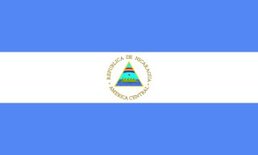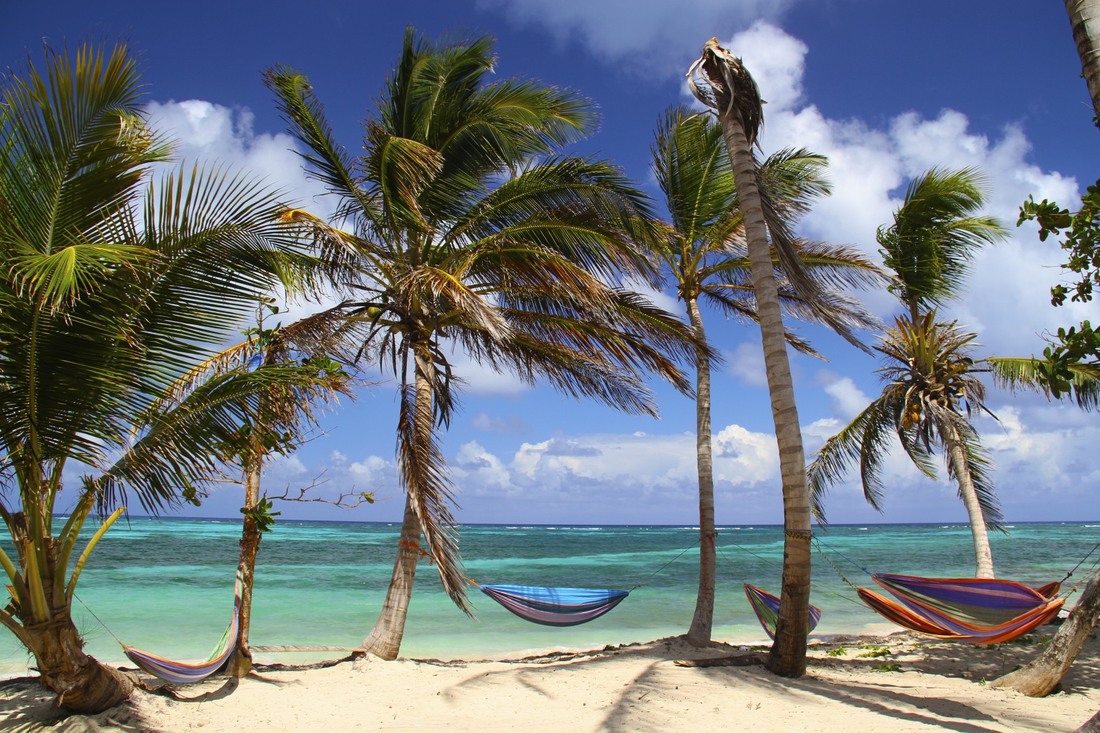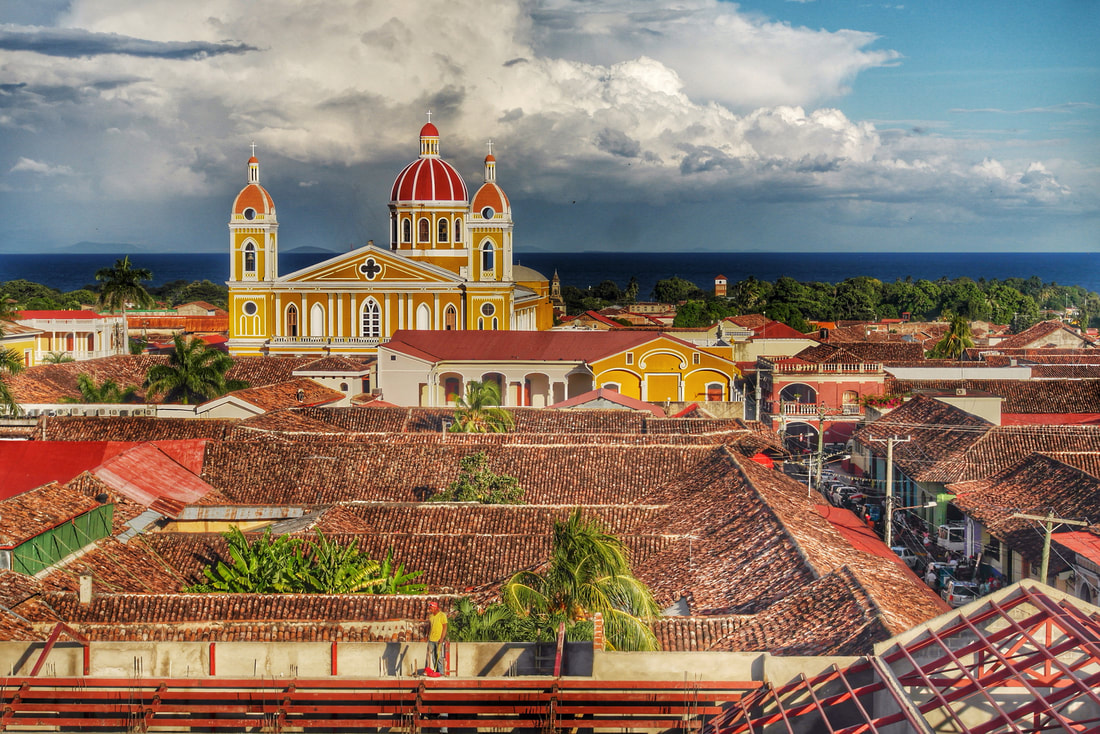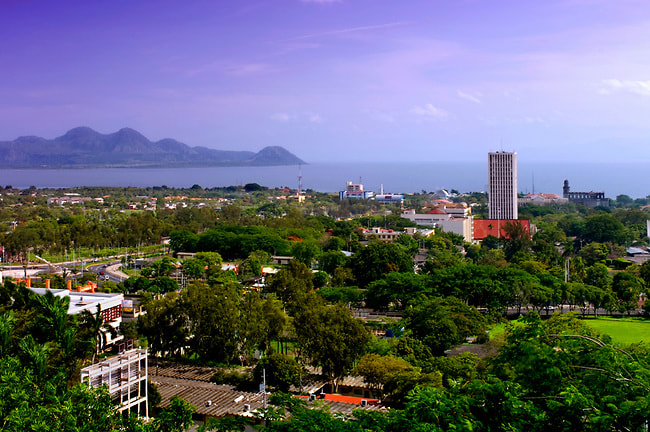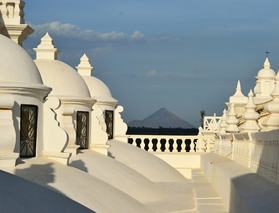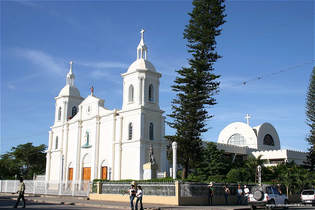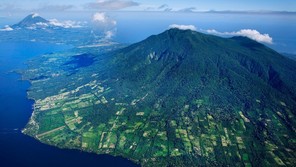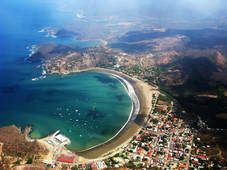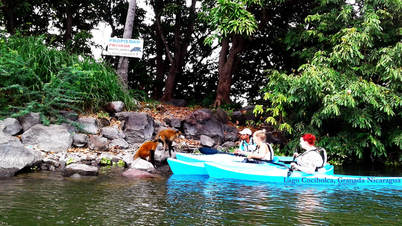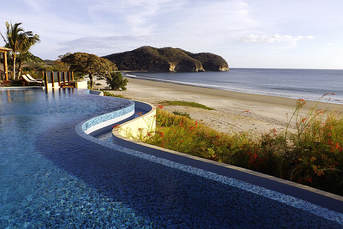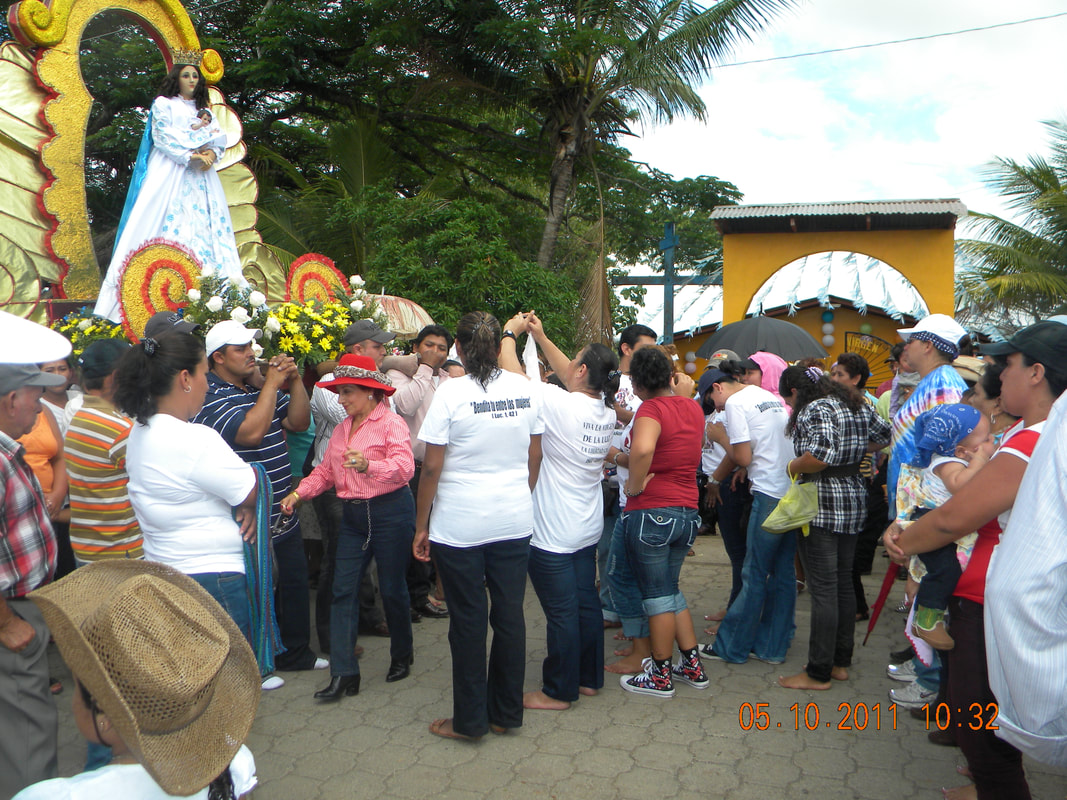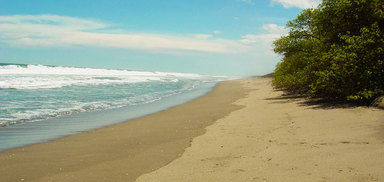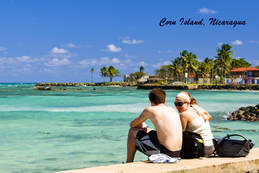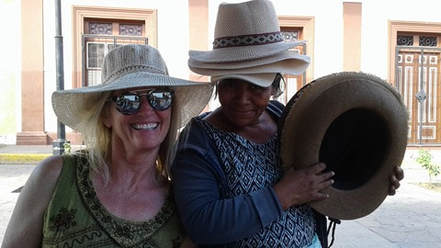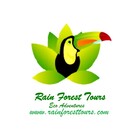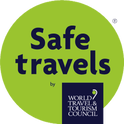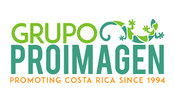NICARAGUA, LAND OF LAKES AND VOLCANOES!
|
|
Nicaragua Top Destinations
|
In today’s shrinking planet few countries can boast such an authentic character and culture as Nicaragua. Sandwiched between Costa Rica and Honduras, and with both Caribbean and Pacific coasts, Nicaragua is a very, very special country, blessed with wonderful scenery, a rich colonial heritage, a taste for the arts, and a strong sense of community and humanity.
Ranked as one of the safest countries in Latin America, Nicaragua is peaceful, democratic and welcoming and will impress you with its’ Pacific Basin, the rich colonial architecture of its two historic cities, Granada and León, the awe inspiring dual volcano island of Ometepe, and the crystal clear waters and laid back atmosphere of the Corn Islands. Nicaragua’s numerous lakes and rivers include Central America’s biggest, Lake Nicaragua, which is punctuated by more than 500 volcanic islands that support unique wildlife and hide ancient indigenous relics. Nicaragua offers: world-class coffee, rum and cigars; cone-shaped volcanoes for hiking up and boarding down; lush rainforests aflutter with butterflies, birds and monkeys; and superb surf and dive spots. All these will sate the sybarite, the adventure-lover, the escapist. Nicaragua also possesses a unique cultural dimension, expressed through extraordinary religious fiestas, authentic folk music, thriving agricultural communities and the poems of “father of modernismo” Rubén Darío (as influential as T S Eliot or Borges, yet not known nearly as well). Your vacation is very important to us and so it is for this reason that we’ve put together this list and guide of travel information, guidelines, and tips to ensure that your vacation is the best that it can be. There are so many reasons to visit this beautiful country, so contact us today and let us help you plan a trip of a lifetime to this land of fire and water! |
|
Corn Islands -CaribbeanThe Corn Islands are two islands 70 kilometers off the Caribbean Coast, in front of the city of Bluefields. These two islands offer a superb opportunity to see the Caribbean side of Nicaragua in a beautiful and mostly unexplored environment. The regular ‘Caribbean’ features are all present: turquoise water, white sand beaches, green palm trees and stunning reefs and marine life.
|
Granada
The colonial city of Granada is one of the most important and most visited destinations in Nicaragua. The architecture of its old center, many museums, galleries, hotels, restaurants, bars and cosmopolitan ambiance make Granada a destination in and of itself. However, it also serves as a great starting point to explore the region.
|
Managua
The capital city of Nicaragua and administrative center of the country, the department of Managua has many attractions. Its territory has coasts on the Pacific Ocean and also goes through the 'Sierras de Managua' (low mountains) and continues on the wide plains that surround most of Lake Xolotlan (also known as Lake Managua).
|
LeonLeón is a land of volcanoes, hot weather and interesting cities. Here, visitors will find the ruins of one of the first Spanish colonial cities that were built in the continent, which are preserved thanks to the volcanic sand that buried the place after an eruption. The elegant city of León preserves its attractive historical center and colonial buildings. There are also many natural attractions as well as little known and remote rural areas.
|
EsteliThe city of Estelí is famous for the tobacco production that takes place in the high quality cigar factories and plantations, located in the urban area. Its active center has a museum, cultural and business center. Besides its many hotels and restaurants, Esteli also has bars and clubs with a good ambiance. Several natural attractions can be found in the Northern department of Esteli, which comprises plateaus divided by hills with multiple climates. Its capital city is dynamic, and most of its towns feature archaeological areas and hard-working artisans.
|
|
Ometepe is currently one of the top destinations admired by both local and international tourists for its nature, hospitality, beautiful landscapes, two volcanoes (Maderas and Concepcion), a rich archeological background, relaxing beaches and its numerous natural reserves and forests with a rich biodiversity.
|
San Juan del Sur is an obligatory stopover for almost every traveler seeking rest and relaxation on unspoilt beaches. The majority of these beaches are located throughout the municipality, including the most famous ones: Marsella, Maderas, Majagual, La Flor, El Ostional, El Coco, Las Salinas, El Astillero and El Yankee.
|
NICARAGUA VACATION PACKAGES
We can customize these itineraries just for you since any element – activities, length, hotels and destinations can be tailored to meet your requirements. We'll make as many changes as it takes until you have exactly what you want, a truly unique travel experience!!! Call us at 1 786 289 0249 or email us @ [email protected] to request a quote or special service.
|
TOBACCO
Nicaraguan Cigars are amongst the best cigars in the world and some of the most coveted cigars are produced with Nicaraguan tobacco. The country has rich & fertile soils for growing tobacco and even has a volcanic island, Ometepe, that grows a rare and unique tobacco for cigars. The nationalization of the Cuban cigar industry in the 1960's after that country's revolution drove some of Cuba's finest cigar producers into exile in Nicaragua in search of new land to grow tobacco and produce their cigars.
The 1970s were among the best years for the Nicaraguan cigar industry, where they produced some of the finest premium cigars in the world, notably the Joya de Nicaragua, which became one of the most popular cigar brands. |
|
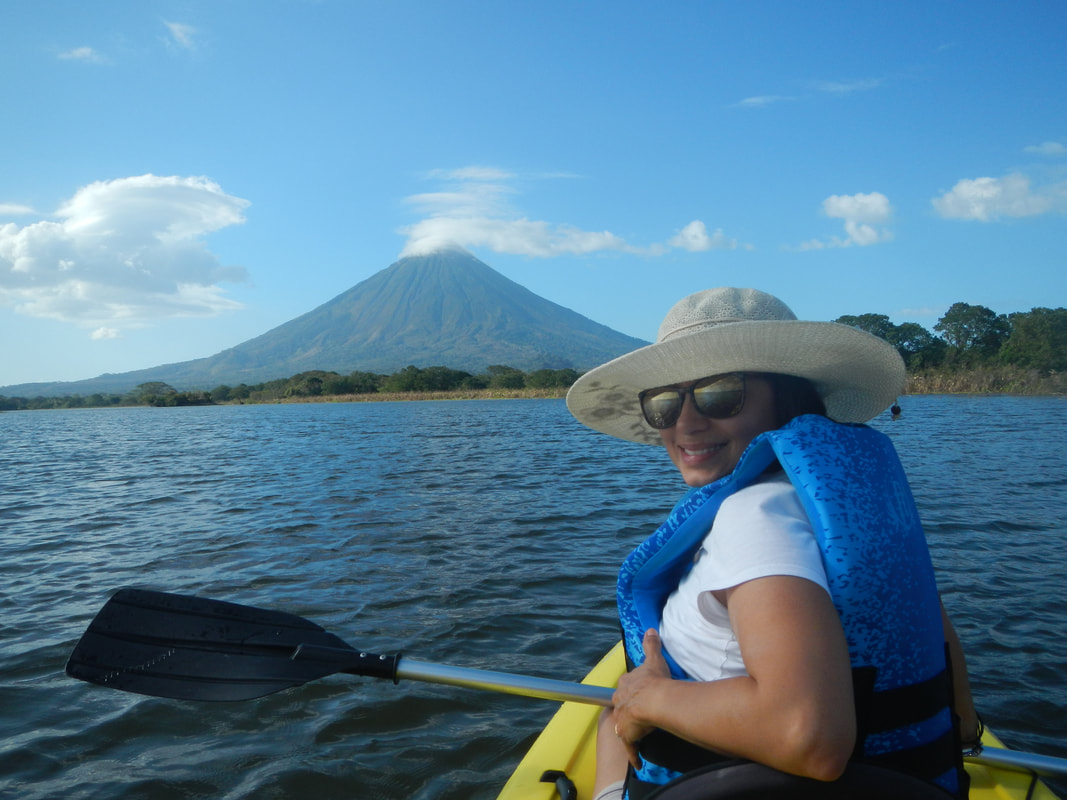
LAKES AND VOLCANOES
The central region of the country also features a large number of cloud forests which further add to the natural diversity. The highest range in Nicaragua is to be found here. It is known as the Cordillera Isabella range, and it features peaks which rise to heights of 6890 ft (2100m). Here you will find incredibly beautiful cloud forests. It is also one of the best areas to visit coffee plantations or to go bird watching. The majority of hiking trails in the country can be found in this part of Nicaragua.
In a country teeming with wildlife and diversity, there is little mystery as to why so many tourists are choosing to visit National Parks in Nicaragua instead of cities and beaches. Nicaragua has some 78 nature reserves, parks and wildlife sanctuaries filled with amazing diversity. Nicaragua has one of the most impressive volcanic chains in Central America. It features more than fifty volcanic cones of which seven are active. These cones rise off a flat coastal plain which is just above sea level – a geographical feature that makes them more striking to look at and more accessible to climbers and hikers. |
NATURE
Nicaragua has so much on offer that it can be difficult trying to decide where to start. White sandy beaches, tropical forests, one of the biggest lakes in Latin America and stunning colonial cities all contribute to a great vacation adventure.
Nicaragua tourism excels because of its amazing natural diversity. The warm ocean water all year round makes for great beach holidays in Nicaragua. The stunning architecture of Nicaraguan cities will captivate old and young. Lakes, lagoons, forests and islands make Nicaragua a true nature lover’s paradise. Lake Nicaragua covers a massive 8000 sq km. This aquatic marvel hosts over 500 tropical inlets and provides shelter for a large variety of birds and other animals, making it a prime tourism destination. Get your adrenaline rush on a canopy tour (zip line) of the forest - swinging from trees on specially adapted cables, or perhaps a picnic beside the stunning waterfalls of La Maquina is more your style? Horse lovers jump at the opportunity to enjoy a scenic horseback ride through indigenous forests while culture lovers can spend hours exploring the interesting history of old fortresses and grand buildings that have spent many decades, if not centuries, baking under the hot Nicaraguan sun. Beach resorts certainly aren’t in short supply and provide the opportunity to soak up the sun, and enjoy a variety of water sports. If you’re not a fan of getting sand on your body but you love going for a splash, there are a number of amazing lakes situated further inland that would make for an excellent swimming venue. Of course, there are several not-to-be-missed attractions in Nicaragua, such as Ometepe Island, the colonial cities of Leon and Granada, and the Caribbean islands of Corn and Little Corn Islands, offering sailing, scuba and sport fishing opportunities. |
|
TRADITIONS AND CULTURE
The blending of different cultures that took place in Nicaragua resulted in the birth of a creative, varied, happy, and humorous people. Even though this culture is barely known worldwide it assures its audience an interesting experience. In the same way, the hospitality, goodness, and friendliness of the Nicaraguan people are recognized by visitors that have the opportunity to get to know this nation. Here is an overview of the Nicaraguan culture. RELIGIOUS FESTIVITIES
Religious celebrations are very important in Nicaragua. The main ones celebrated are Christmas, Holy Thursday, Good Friday, and the Immaculate Conception (Dec 8th). The most important holiday in Nicaragua is La Purísima. It's a week long celebration of the Immaculate Conception and is a very exciting time for Nicaraguans. Religious celebrations are loud, crowded events in Nicaragua. Having saints as inspirations, numerous dances, music and traditional interpretation have been made. Each city and each town has their own ‘Saint boss’ or ‘Santo Patrono’ as they are called in Nicaragua, designated since colonial times. These festivities that take place when the inhabitants of each town honor their Saint are called ‘Fiestas Patronales’, and they continue for several days in a row. These celebrations are very colorful, folkloric and crowded; they are a real manifestation of the Nicaraguan culture. MUSIC AND DANCES Nicaraguan music and dances are a product of the heritage and the mixture of different cultures from indigenous tribes, European conquerors, and African slaves. The music and dances were born in the different regions of the country. Even though each region has its own traditions, all Nicaraguans consider themselves to share one cultural identity. This is why dances from the Caribbean Coast (that have a lot of African influence) are danced in the Pacific, and northern dances are just as well performed in the south. |
SECULAR CELEBRATIONS
Some non-religious holidays celebrated in Nicaragua include: New Year's Liberation Day (July 18th) Labor Day (May 1st) Independence Day (Sept. 15th) Secular Holidays are very similar to American's holidays, and are celebrated with just as much excitement as Nicaragua's religious celebrations. |
NICARAGUA NORTH TO SOUTH (13 DAYS / 12 NIGHTS) Package |
NICARAGUAN ODYSSEY (13 DAYS / 12 NIGHTS)
|
|
PEOPLE
The people of Nicaragua are warm and generous which is surprising to many due to the media’s constantly replayed images of their war-torn past. There are many stories of expatriates or tourists having vehicle problems or other issues in the middle of nowhere and having a local Nica family with little or nothing offering their home, food and assistance.
The most outstanding characteristic about the Nicaraguan people is their kindness, which you will notice almost immediately because they are always helpful and will offer you their friendship without hesitation. |
The Nicaraguan cigar industry suffered a major setback in 1998 when Hurricane Mitch wiped out the majority of the tobacco crop and caused widespread damage that killed thousands of people. Many regions received a year's worth of rain in just four days that did much damage and in some fields the topsoil of entire fields were washed away completely, leaving a field of rocks. After this natural destruction, the cigar plantations would once again start over. With the resiliency of the Nicaraguan cigar producers and the political situation more stable over the past decade, Nicaragua has become one of the top producing cigar countries in the world.
Most of the cigar plantations and factories can be found in and around the city of Estelí. The Nicaraguan cigars from this region are high quality and sold in the U.S. and Europe. There are a couple cigar factories where you as a tourist can walk around and see how things are done. You can see also see how the tobacco plants grow and how they are harvested (if you're there in the right season). In an office on the same lot you can see men and women selecting, cutting, rolling, ordering, and packing the cigars. You will also have the opportunity to buy some of the hand-made cigars, so be sure to bring a couple home to please cigar smoking friends or to just reward the company for their open-house policy.
Most of the cigar plantations and factories can be found in and around the city of Estelí. The Nicaraguan cigars from this region are high quality and sold in the U.S. and Europe. There are a couple cigar factories where you as a tourist can walk around and see how things are done. You can see also see how the tobacco plants grow and how they are harvested (if you're there in the right season). In an office on the same lot you can see men and women selecting, cutting, rolling, ordering, and packing the cigars. You will also have the opportunity to buy some of the hand-made cigars, so be sure to bring a couple home to please cigar smoking friends or to just reward the company for their open-house policy.
GENERAL INFORMATION ABOUT NICARAGUA
Climate
Nicaragua enjoys an avg. temperature of 27 degrees celsius (80 degrees F) year round with two seasons; rainy (green) and dry (summer). Rainy season occurs from mid-May to mid-November, and summer from late November to early May. The hottest time of the year is at the end of the summer, from March to May, while the coolest periods are from October to January. The most pleasant months to visit Nicaragua are from June to January, unless visiting the San Juan River and Solintename rain forest areas, in which case July, August and December - March are best.
There are three temperature zones in Nicaragua. In the lowlands (Pacific and Atlantic coast) temperatures vary roughly between 72° F at night and 86° F at daytime (22° C - 30° C). Temperature can reach 100° F in May (38° C). The central part of the country is about 9° F (5° C) cooler, and in the mountains in the north it's about 18° F (10° C) cooler.
Location and Topography
Nicaragua is Central America’s biggest country and is bordered to the North by Honduras and the Gulf of Fonseca and to the South by Costa Rica and has both a Pacific and Atlantic / Caribbean Coast. The Pacific Basin is blessed with a spine of more than 50 volcanoes that run from the Golf of Fonseca south into Lake Nicaragua, of which 7 are active and 14 possess crater lakes. The Pacific Basin is separated from the central and northern mountain and eastern rain forests by Central America’s two biggest lakes; Lake Managua and Lake Nicaragua (Cocibolca). Lake Nicaragua is home to over 450 volcanic island, including the world’s biggest volcanic lake island, Ometepe, and 5 distinct archipelagos. A full 10% of Nicaragua is covered by lakes, rivers, and lagoons, 35% forests, and the remaining 55% a mixture of grazing and farm lands with scattered villages and cities.
International Flights to Nicaragua
Managua International Airport is the only international airport servicing Nicaragua with the following airlines;
American Airlines: 3 daily non-stops from Miami
Delta Airlines: 1 daily non-stop from Atlanta
United Airlines: 2 daily non-stops from Houston
Spirit Airlines: non-stop Monday, Thursday, and Saturday from Ft. Lauderdale
Copa Airlines: 2 daily from San Jose, Costa Rica and Panama, 1 daily from Guatemala
Avianca Airlines: 1 daily non-stop from Miami and San Jose, 3 daily non-stops from San Salvador
Entry and exit requirements
All visitors are required to present passports valid for at least ninety days in order to enter Nicaragua as well as a return flight ticket to country of origin. In addition, guests 17 years of age or younger may be required to show additional documentation when traveling with a single parent. Visas are not required for citizens of most countries, including those of Western Europe, Canada and the U.S.
Currency, banking, credit cards
The Nicaraguan monetary unit is the Cordoba and the current exchange rate is around 30 cordobas to $1.00 U.S. Most hotels and restaurants will accept US dollars and major credit cards (Visa, Master Card, and American Express), it is important to inform your credit card company or bank before leaving home that you will be visiting Costa Rica. There are also numerous ATM's in Managua, Granada, and Leon, less so outsider of major cities. Traveler’s checks are not recommended.
Electricity
Standard current is 110 volts, 60 Hertz.
Telecommunications
Wifi service is widespread and efficient.
Food
The Nicaraguan culinary art dates back to the pre-Colombian times, as you can tell by the names of the most known plates. Back then, during colonial times, the peculiar, creative, and varied Creole menu was the result of the union of these two races. In this type of food, ranging from soups and meats to a diversity of sweets, interesting ingredients are used. Since its origin, the fundamental basis of Nicaraguan gastronomy has been corn. Thus, its wide usage and derivatives constitutes the culinary inheritance left by indigenous tribes that lived in the area. This fact explains the similarities between the typical Nicaraguan food and those of other countries in the Central American region and Mexico. We all were sons of corn. Corn, as ingredient, has many different uses: lots of drinks are made from corn, such as Chicha and Pinol; as well main dishes such as Nacatamal, Indio Viejo, and Sopa de Albondiga; and snacks and sweets such as Atolillo and Perrereque. There are also other ingredients widely used in the Nicaraguan kitchen, mostly local, tropical products. Nevertheless, Nicaraguan culinary creativity is meticulous and open, which enables the utilization of ingredients used all around the world such as tomato, onion, garlic, flour, rice, orange, mustard and mayonnaise, milk and cheese, vanilla, cinnamon, and more. There are a lot traditional Nicaraguan dishes and each region, according to geographical and cultural characteristics, produced various dishes, drinks, and sweets. Throughout the years however, those dishes became known in the whole country. Some cities still are recognized as the ones that originated some of theses specialties, but most of these passed on to become national dishes.
Due to its' geographical location and climate, Nicaragua has a wealth of fruits and vegetables and calorie counters may prefer a tropical fruit plate of papaya, watermelon, pineapple, banana, and in season mango or cantaloupe.
Transportation
There are a large number of affordable taxis in the cities, and domestic airlines that service some of the tourist areas. There are many rental car companies that offer service in Nicaragua and an international driver's permit is not necessary. A valid driver’s license from your home country will suffice.
Taxes
Nicaragua has a nationwide 17% sales tax and a 10% service charge (tip) is added to all restaurant bills. Airport entrance tax for visitors is $10.00
Population
Nicaragua has a population of 5.8 million people making it the least densely populated country in Central America.
Language
Spanish is the native language, but other languages such as English, French, Italian, and German are widely spoken especially in the tourist areas.
Time Zone
Nicaragua is on the equivalent of Central Standard Time and Daylight Savings Time is not observed.
Nicaragua enjoys an avg. temperature of 27 degrees celsius (80 degrees F) year round with two seasons; rainy (green) and dry (summer). Rainy season occurs from mid-May to mid-November, and summer from late November to early May. The hottest time of the year is at the end of the summer, from March to May, while the coolest periods are from October to January. The most pleasant months to visit Nicaragua are from June to January, unless visiting the San Juan River and Solintename rain forest areas, in which case July, August and December - March are best.
There are three temperature zones in Nicaragua. In the lowlands (Pacific and Atlantic coast) temperatures vary roughly between 72° F at night and 86° F at daytime (22° C - 30° C). Temperature can reach 100° F in May (38° C). The central part of the country is about 9° F (5° C) cooler, and in the mountains in the north it's about 18° F (10° C) cooler.
Location and Topography
Nicaragua is Central America’s biggest country and is bordered to the North by Honduras and the Gulf of Fonseca and to the South by Costa Rica and has both a Pacific and Atlantic / Caribbean Coast. The Pacific Basin is blessed with a spine of more than 50 volcanoes that run from the Golf of Fonseca south into Lake Nicaragua, of which 7 are active and 14 possess crater lakes. The Pacific Basin is separated from the central and northern mountain and eastern rain forests by Central America’s two biggest lakes; Lake Managua and Lake Nicaragua (Cocibolca). Lake Nicaragua is home to over 450 volcanic island, including the world’s biggest volcanic lake island, Ometepe, and 5 distinct archipelagos. A full 10% of Nicaragua is covered by lakes, rivers, and lagoons, 35% forests, and the remaining 55% a mixture of grazing and farm lands with scattered villages and cities.
International Flights to Nicaragua
Managua International Airport is the only international airport servicing Nicaragua with the following airlines;
American Airlines: 3 daily non-stops from Miami
Delta Airlines: 1 daily non-stop from Atlanta
United Airlines: 2 daily non-stops from Houston
Spirit Airlines: non-stop Monday, Thursday, and Saturday from Ft. Lauderdale
Copa Airlines: 2 daily from San Jose, Costa Rica and Panama, 1 daily from Guatemala
Avianca Airlines: 1 daily non-stop from Miami and San Jose, 3 daily non-stops from San Salvador
Entry and exit requirements
All visitors are required to present passports valid for at least ninety days in order to enter Nicaragua as well as a return flight ticket to country of origin. In addition, guests 17 years of age or younger may be required to show additional documentation when traveling with a single parent. Visas are not required for citizens of most countries, including those of Western Europe, Canada and the U.S.
Currency, banking, credit cards
The Nicaraguan monetary unit is the Cordoba and the current exchange rate is around 30 cordobas to $1.00 U.S. Most hotels and restaurants will accept US dollars and major credit cards (Visa, Master Card, and American Express), it is important to inform your credit card company or bank before leaving home that you will be visiting Costa Rica. There are also numerous ATM's in Managua, Granada, and Leon, less so outsider of major cities. Traveler’s checks are not recommended.
Electricity
Standard current is 110 volts, 60 Hertz.
Telecommunications
Wifi service is widespread and efficient.
Food
The Nicaraguan culinary art dates back to the pre-Colombian times, as you can tell by the names of the most known plates. Back then, during colonial times, the peculiar, creative, and varied Creole menu was the result of the union of these two races. In this type of food, ranging from soups and meats to a diversity of sweets, interesting ingredients are used. Since its origin, the fundamental basis of Nicaraguan gastronomy has been corn. Thus, its wide usage and derivatives constitutes the culinary inheritance left by indigenous tribes that lived in the area. This fact explains the similarities between the typical Nicaraguan food and those of other countries in the Central American region and Mexico. We all were sons of corn. Corn, as ingredient, has many different uses: lots of drinks are made from corn, such as Chicha and Pinol; as well main dishes such as Nacatamal, Indio Viejo, and Sopa de Albondiga; and snacks and sweets such as Atolillo and Perrereque. There are also other ingredients widely used in the Nicaraguan kitchen, mostly local, tropical products. Nevertheless, Nicaraguan culinary creativity is meticulous and open, which enables the utilization of ingredients used all around the world such as tomato, onion, garlic, flour, rice, orange, mustard and mayonnaise, milk and cheese, vanilla, cinnamon, and more. There are a lot traditional Nicaraguan dishes and each region, according to geographical and cultural characteristics, produced various dishes, drinks, and sweets. Throughout the years however, those dishes became known in the whole country. Some cities still are recognized as the ones that originated some of theses specialties, but most of these passed on to become national dishes.
Due to its' geographical location and climate, Nicaragua has a wealth of fruits and vegetables and calorie counters may prefer a tropical fruit plate of papaya, watermelon, pineapple, banana, and in season mango or cantaloupe.
Transportation
There are a large number of affordable taxis in the cities, and domestic airlines that service some of the tourist areas. There are many rental car companies that offer service in Nicaragua and an international driver's permit is not necessary. A valid driver’s license from your home country will suffice.
Taxes
Nicaragua has a nationwide 17% sales tax and a 10% service charge (tip) is added to all restaurant bills. Airport entrance tax for visitors is $10.00
Population
Nicaragua has a population of 5.8 million people making it the least densely populated country in Central America.
Language
Spanish is the native language, but other languages such as English, French, Italian, and German are widely spoken especially in the tourist areas.
Time Zone
Nicaragua is on the equivalent of Central Standard Time and Daylight Savings Time is not observed.
